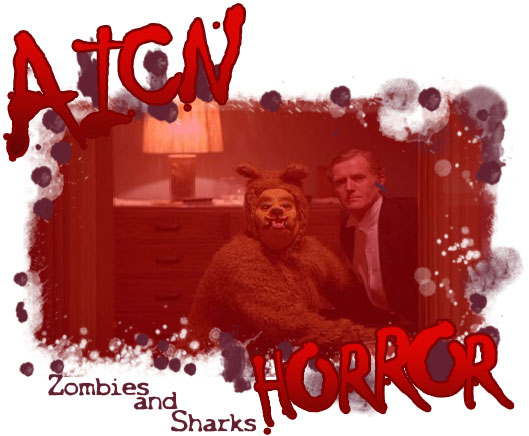
Greetings, all. Ambush Bug here with another AICN HORROR: ZOMBIES & SHARKS column. Better late than never, not because of my fellow @$$Hole BottleImp either, here is a column dedicated solely to Stephen King. Love him or hate him, looking back at all of the books and films dedicated to the King’s work, you have to admit the guy has made an undeniable impact on the horror genre. The reason for this column is the recent release of JOYLAND, which BottleImp reviews towards the bottom of the column. But I also said a few words about UNDER THE DOME, which I just recently saw, to make this whole thing timelier than ever. So sit back and enjoy these glances back at some of the best and not so best works of Stephe King!
(Click title to go directly to the feature)
Retro-review: THE SHINING (1980)
Retro-review: THE DEAD ZONE (1983)
Retro-review: CHILDREN OF THE CORN (1984)
Retro-review: MISERY (1990)
Retro-review: SLEEPWALKERS (1992)
Short Cuts Short Film Review: SURVIVOR TYPE (2012)
Book review: JOYLAND (2013)
UNDER THE DOME Episodes 1-2 (2013)
And finally…MUCH MORE SHINING!

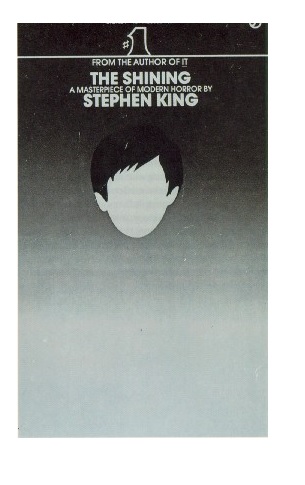 Retro-review: Find this film on Netflix here!
Retro-review: Find this film on Netflix here!THE SHINING (1980)
Directed by Stanley KubrickWritten by Stanley Kubrick & Diane Johnson (based upon the novel by Stephen King)
Starring Jack Nicholson, Shelley Duvall, Danny Lloyd, Scatman Crothers, Philip Stone, Joe Turkel
Retro-reviewed by BottleImp
What can I say about THE SHINING that hasn’t been said already? There’s even a documentary that was released last year (ROOM 237) all about the various interpretations of Stanley Kubrick’s classic. The story of Jack Torrance (Jack Nicholson) and his descent into madness at the Overlook Hotel has been discussed, dissected and analyzed to death… but I’ll add another corpse to the pile.
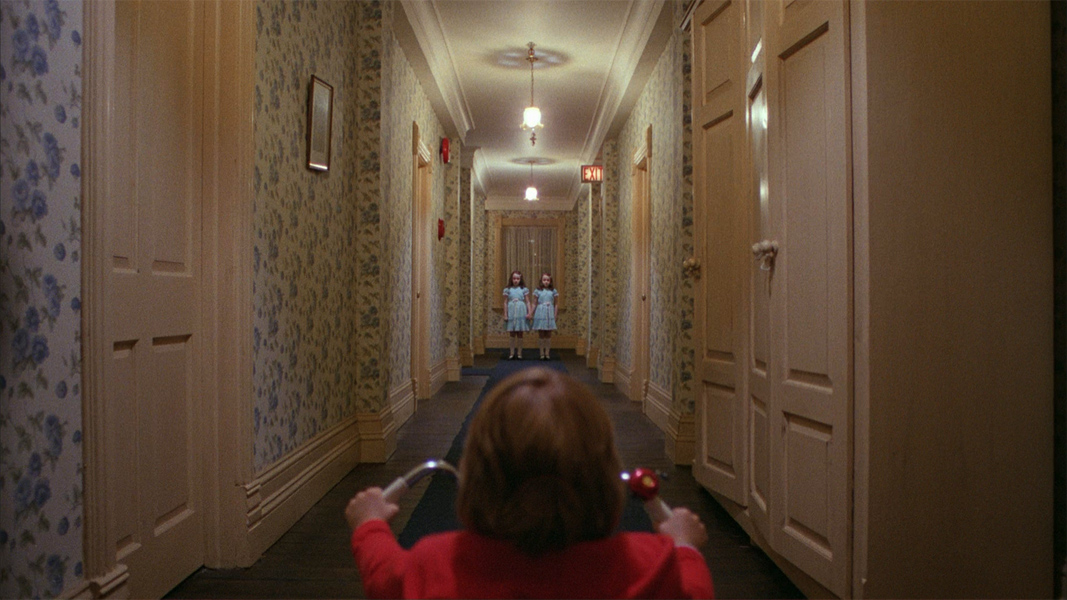 Stephen King is famously not a fan of Kubrick’s treatment of his novel, citing dissatisfaction with casting (King felt that Nicholson was too clearly crazy right from the start, while Shelley Duvall’s portrayal of Wendy Torrance was at odds with the author’s vision of Jack’s wife as a “former cheerleader type”) as well as some of the alterations to the original plot. The most striking delineation between King’s novel and Kubrick’s film is that in the book, it is clearly stated that the evil of the Overlook is intent on absorbing young Danny Torrance because of his “shining” ability—that is, his innate psychic talents. In the movie, Danny (Danny Lloyd) and his abilities become almost incidental to the plot as Kubrick instead chooses to focus on the relationship between Jack and the hotel. In THE SHINING Jack clearly feels like he belongs at the Overlook, telling Wendy at the beginning of the movie that he felt like he had been there before. When Jack meets what seems to be the ghost of the last caretaker, Delbert Grady (Philip Stone), Grady intones chillingly, “You are the caretaker, sir. You have always been the caretaker.” And as the viewer sees in the final shot of the film, Jack will always be the caretaker at the Overlook.
Stephen King is famously not a fan of Kubrick’s treatment of his novel, citing dissatisfaction with casting (King felt that Nicholson was too clearly crazy right from the start, while Shelley Duvall’s portrayal of Wendy Torrance was at odds with the author’s vision of Jack’s wife as a “former cheerleader type”) as well as some of the alterations to the original plot. The most striking delineation between King’s novel and Kubrick’s film is that in the book, it is clearly stated that the evil of the Overlook is intent on absorbing young Danny Torrance because of his “shining” ability—that is, his innate psychic talents. In the movie, Danny (Danny Lloyd) and his abilities become almost incidental to the plot as Kubrick instead chooses to focus on the relationship between Jack and the hotel. In THE SHINING Jack clearly feels like he belongs at the Overlook, telling Wendy at the beginning of the movie that he felt like he had been there before. When Jack meets what seems to be the ghost of the last caretaker, Delbert Grady (Philip Stone), Grady intones chillingly, “You are the caretaker, sir. You have always been the caretaker.” And as the viewer sees in the final shot of the film, Jack will always be the caretaker at the Overlook. In many ways Kubrick’s version of King’s story is kin to the type of psychological horror found in another famous haunted house story, Shirley jackson’s “The Haunting of Hill House” (filmed as the excellent THE HAUNTING in 1963 and re-filmed as the awful THE HAUNTING in 1999). Like Jackson’s Eleanor, Kubrick’s version of Jack is someone who is unhappy in life and wants a place where he feels he belongs. In THE SHINING Nicholson’s Jack seems like someone who lives with constant, barely contained resentment at the hand he’s been dealt. It has been said that part of the reason for casting Duvall as Jack’s wife was that Kubrick wanted Wendy to be someone who needed her husband more than he needed her. Several times in the film Jack makes references to Wendy somehow screwing up his life and his plans—it’s never said, but one gets the feeling that in Kubrick’s mind the only reason that Jack married Wendy was because she got pregnant with Danny. But whereas Hill House gives Eleanor what she wants in a home that she is at last welcome in, the Overlook gives Jack the permission to give in to his buried feelings and brutally divest himself of the burden that he clearly feels is his family.
In many ways Kubrick’s version of King’s story is kin to the type of psychological horror found in another famous haunted house story, Shirley jackson’s “The Haunting of Hill House” (filmed as the excellent THE HAUNTING in 1963 and re-filmed as the awful THE HAUNTING in 1999). Like Jackson’s Eleanor, Kubrick’s version of Jack is someone who is unhappy in life and wants a place where he feels he belongs. In THE SHINING Nicholson’s Jack seems like someone who lives with constant, barely contained resentment at the hand he’s been dealt. It has been said that part of the reason for casting Duvall as Jack’s wife was that Kubrick wanted Wendy to be someone who needed her husband more than he needed her. Several times in the film Jack makes references to Wendy somehow screwing up his life and his plans—it’s never said, but one gets the feeling that in Kubrick’s mind the only reason that Jack married Wendy was because she got pregnant with Danny. But whereas Hill House gives Eleanor what she wants in a home that she is at last welcome in, the Overlook gives Jack the permission to give in to his buried feelings and brutally divest himself of the burden that he clearly feels is his family.Another reason that King disliked Kubrick’s take is that he felt that the message of alcoholism (a very personal one to the author) had been ignored. I happen to disagree with King on this one; it’s said that alcohol doesn’t change a person, but rather reveals who that person really is. If we take that idea and apply it to the Overlook Hotel itself—the hotel actually becoming the drug for Jack to imbibe—then we can see Jack’s descent into madness brought on by the hotel’s evil as a metaphor for the behavior caused by an alcoholic’s drinking. The Overlook allows Jack to lower his defenses and lose his inhibitions, which is why he falls under its sway so readily.
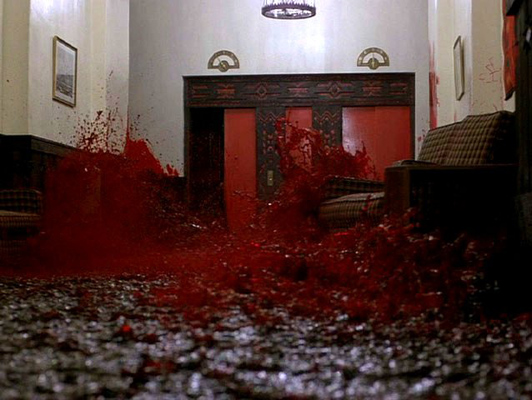 We could talk about metaphor and symbolism ‘til my fingers cramp up, but let’s talk a bit about the greatest achievement of this movie: the almost unbearable sense of dread that it inspires. The deliberately, tantalizingly slow pacing of the camera juxtaposed with the breakneck speed as we follow Danny’s tricycle down the hallways of the hotel, the looming, labyrinthine mass of the hedge maze echoing the Overlook’s mazelike corridors, the surreal, nightmarish mood established by Wendy Carlos’ ominous score and the brilliant sound design—all these elements, combined with terrific performances from Nicholson and Duvall, give THE SHINING a tension that builds up for such a long period that the final release as Jack bursts through the door comes as almost a relief. The spectral apparitions that Wendy finally sees—the man in the dog suit, the bloody-headed party-goer and (most laughably) the lobby festooned with skeletons and cobwebs, are merely footnotes to the true horror of watching the hotel devour Jack’s mind.
We could talk about metaphor and symbolism ‘til my fingers cramp up, but let’s talk a bit about the greatest achievement of this movie: the almost unbearable sense of dread that it inspires. The deliberately, tantalizingly slow pacing of the camera juxtaposed with the breakneck speed as we follow Danny’s tricycle down the hallways of the hotel, the looming, labyrinthine mass of the hedge maze echoing the Overlook’s mazelike corridors, the surreal, nightmarish mood established by Wendy Carlos’ ominous score and the brilliant sound design—all these elements, combined with terrific performances from Nicholson and Duvall, give THE SHINING a tension that builds up for such a long period that the final release as Jack bursts through the door comes as almost a relief. The spectral apparitions that Wendy finally sees—the man in the dog suit, the bloody-headed party-goer and (most laughably) the lobby festooned with skeletons and cobwebs, are merely footnotes to the true horror of watching the hotel devour Jack’s mind.King’s book is a good one, and as read is just about as creepy as it gets. But often what works as prose will not work when presented visually, and such is the case with “The Shining.” If you need any more proof, look no further than King’s own adaptation for television from 1997. This miniseries penned by King adhered stringently to the source material… and definitely suffered for it. Kubrick’s THE SHINING may not be what King envisioned when he wrote his novel, but it is one of the best films to be made from the author’s work.
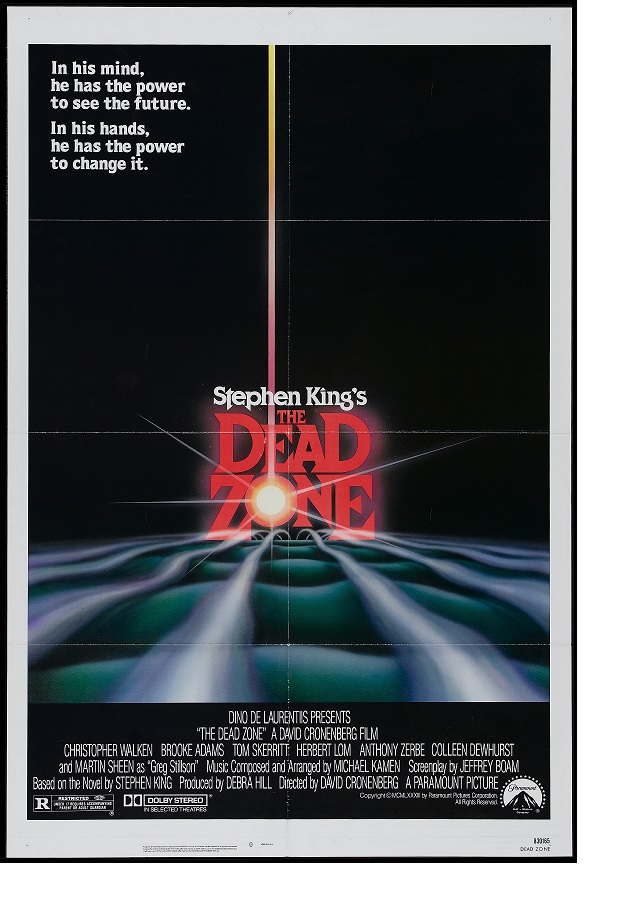
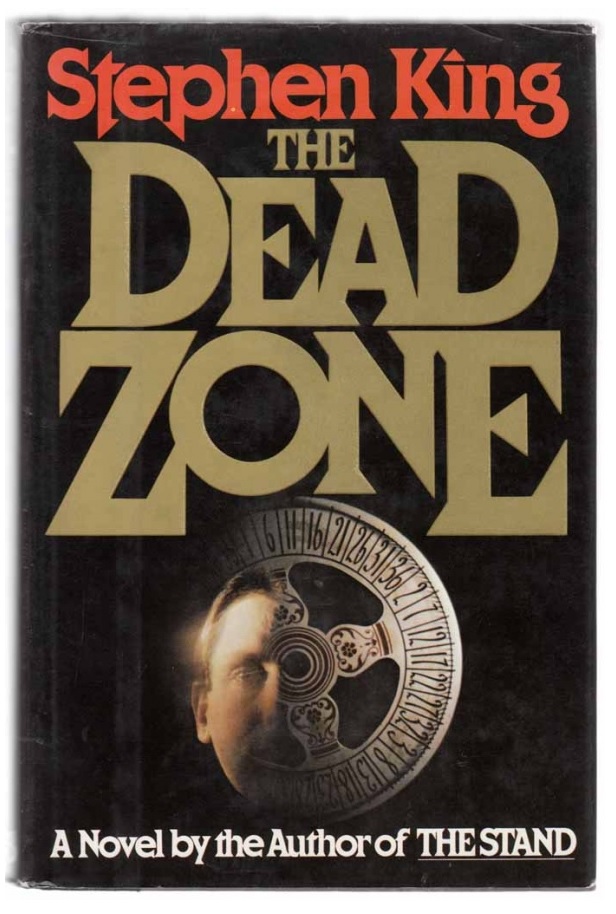 Retro-review: Find this film on Netflix here!
Retro-review: Find this film on Netflix here!THE DEAD ZONE (1983)
Directed by David CronenbergWritten by Jeffrey Boam (based on the novel by Stephen King)
Starring Christopher Walken, Brooke Adams, Tom Skerritt, Herbert Lom, Anthony Zerbe, Colleen Dewhurst, Martin Sheen, Nicholas Campbell, Sean Sullivan, Jackie Burroughs
Retro-reviewed by Ambush Bug
Parodies on SNL and remade into a shitty cable TV series with Anthony Michael Hall, the original THE DEAD ZONE is definitely one of King’s more freakier of adaptations. The freakiness mainly comes from star Christopher Walken, but director David Cronenberg also adds his own freak vibe as well in heavy doses.
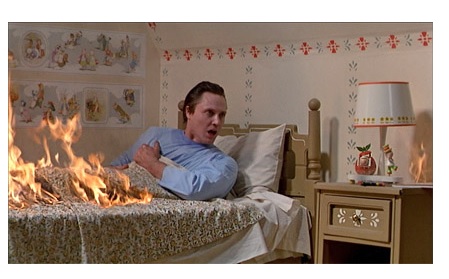 After an auto accident, Walken’s character Johnny Smith awakens having slept for five years, finding out that the love of his life Brooke Adams (INVASION OF THE BODY SNATCHERS) has moved on and married. Smith finds himself a man without loved ones (besides his nagging mother), without purpose, without a life. But it’s not love after he awakens that Smith finds that he has developed the power of second sight and simply by touching someone, he can sense when something bad is going to happen to that person. This power takes Smith on quite a journey as there are those who don’t want him to use his powers, while others want to use them for dastardly deeds.
After an auto accident, Walken’s character Johnny Smith awakens having slept for five years, finding out that the love of his life Brooke Adams (INVASION OF THE BODY SNATCHERS) has moved on and married. Smith finds himself a man without loved ones (besides his nagging mother), without purpose, without a life. But it’s not love after he awakens that Smith finds that he has developed the power of second sight and simply by touching someone, he can sense when something bad is going to happen to that person. This power takes Smith on quite a journey as there are those who don’t want him to use his powers, while others want to use them for dastardly deeds.Delivered in the staccato, beat poetry form as only Walken can do, the moments of psychic activity are ripe for parody. Looking back on Walken in full on Walken mode, it’s hard not to laugh at his performance. Still, this was before the actor became a parody of himself, and his performance here as a man cursed by missing out an important section of his life only to be doubly cursed once he wakes up to find that his psychic gift is a heavy weight to bear, is impressive and heart wrenching. Seeing the pain in Walken’s eyes as he deals with this knowledge makes for riveting stuff.
THE DEAD ZONE occurred when both Stephen King and David Cronenberg were at the height of their own dissections of psychic phenomena with their works. With CARRIE and later FIRESTARTER, the story is somewhat familiar as the person with power is portrayed as a loner with a heavy burden of power to bear. Same goes for Cronenberg who directed SCANNERS (reviewed here) which delves in very similar territory as well. THE DEAD ZONE kind of feels like the culmination of all of these examinations, making the psychic troubles of Johnny Smith all the more interesting.
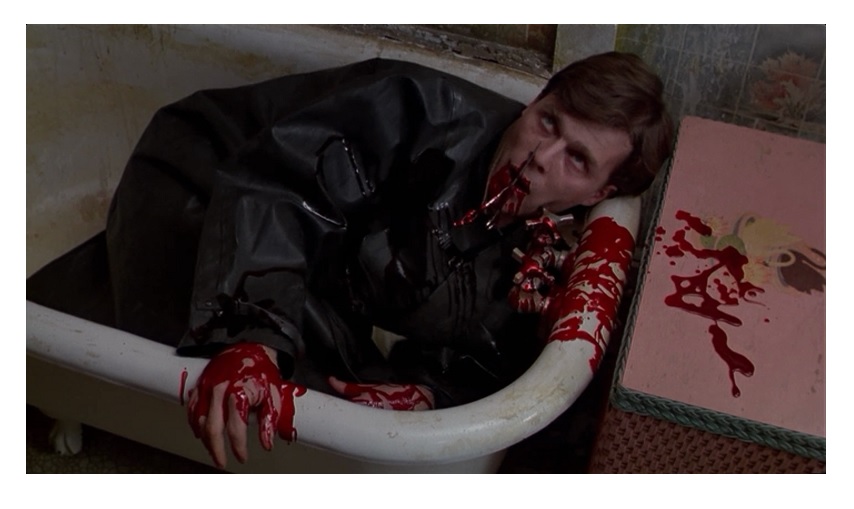 Cronenberg and King offer up quite a few moments of sheer horror, especially when Smith is helping the police find a serial rapist/killer. The scene where Smith sees the murder through the murderer’s eyes is a truly haunting one as is the manhunt afterwards, resulting in the killer meeting his demise through a pretty bizarre method. There is a palpable sense of horror in these moments as the killer lowers his own face towards scissors, which is not a really effective or painless way to go, but it sure looks nasty.
Cronenberg and King offer up quite a few moments of sheer horror, especially when Smith is helping the police find a serial rapist/killer. The scene where Smith sees the murder through the murderer’s eyes is a truly haunting one as is the manhunt afterwards, resulting in the killer meeting his demise through a pretty bizarre method. There is a palpable sense of horror in these moments as the killer lowers his own face towards scissors, which is not a really effective or painless way to go, but it sure looks nasty.Tensions are ratcheted up even more when the ethical debate asking “If you had a time machine, would you go back in time and kill Hitler?” is put into play. Here, Smith predicts the end of the world as a presidential candidate Martin Sheen (everyone’s favorite WEST WING President), shows that he’s got an itchy trigger finger when it comes to nuclear war. Though very little detail is given in regards to why Sheen’s character wants to drop the bomb aside from notoriety of being the one who does it, the fact that it takes precedence during the latter half of the film is definitely indicative of the Cold War scary time the film was made.
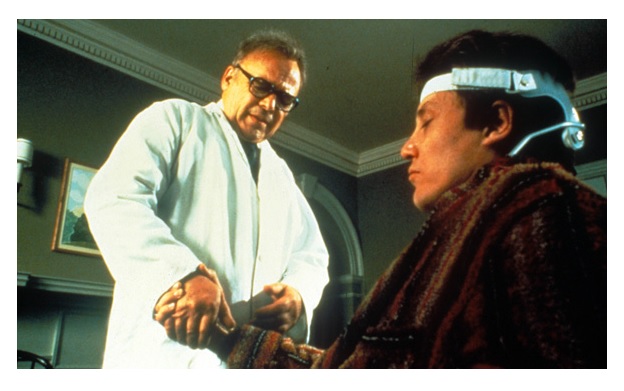 But center stage here is Walken’s performance and I’m one of those people who can watch Walken do anything and be entertained. Here he has a lot of contrived stuff to do—the latter half of the film with the assassination of the presidential candidate not only feels like a response to the Cold War, but of Reagan’s assassination attempt from just a few years prior to the film. I can see why the film spurned a franchise TV series as Smith’s helping of the police is ripe material to be used in case of the week weekly doses. But Walken does it well and his other worldly presence shines bright here in this truly quirky role.
But center stage here is Walken’s performance and I’m one of those people who can watch Walken do anything and be entertained. Here he has a lot of contrived stuff to do—the latter half of the film with the assassination of the presidential candidate not only feels like a response to the Cold War, but of Reagan’s assassination attempt from just a few years prior to the film. I can see why the film spurned a franchise TV series as Smith’s helping of the police is ripe material to be used in case of the week weekly doses. But Walken does it well and his other worldly presence shines bright here in this truly quirky role.Though CARRIE is the highlight of King’s psychic phenomena stories, I feel THE DEAD ZONE was one of his most effective as he seems to have fun with setting Smith up with all sorts of moral, ethical, and psychic challenges along the way. It might be overshadowed by other psychic films, but THE DEAD ZONE is definitely one of the more effective.
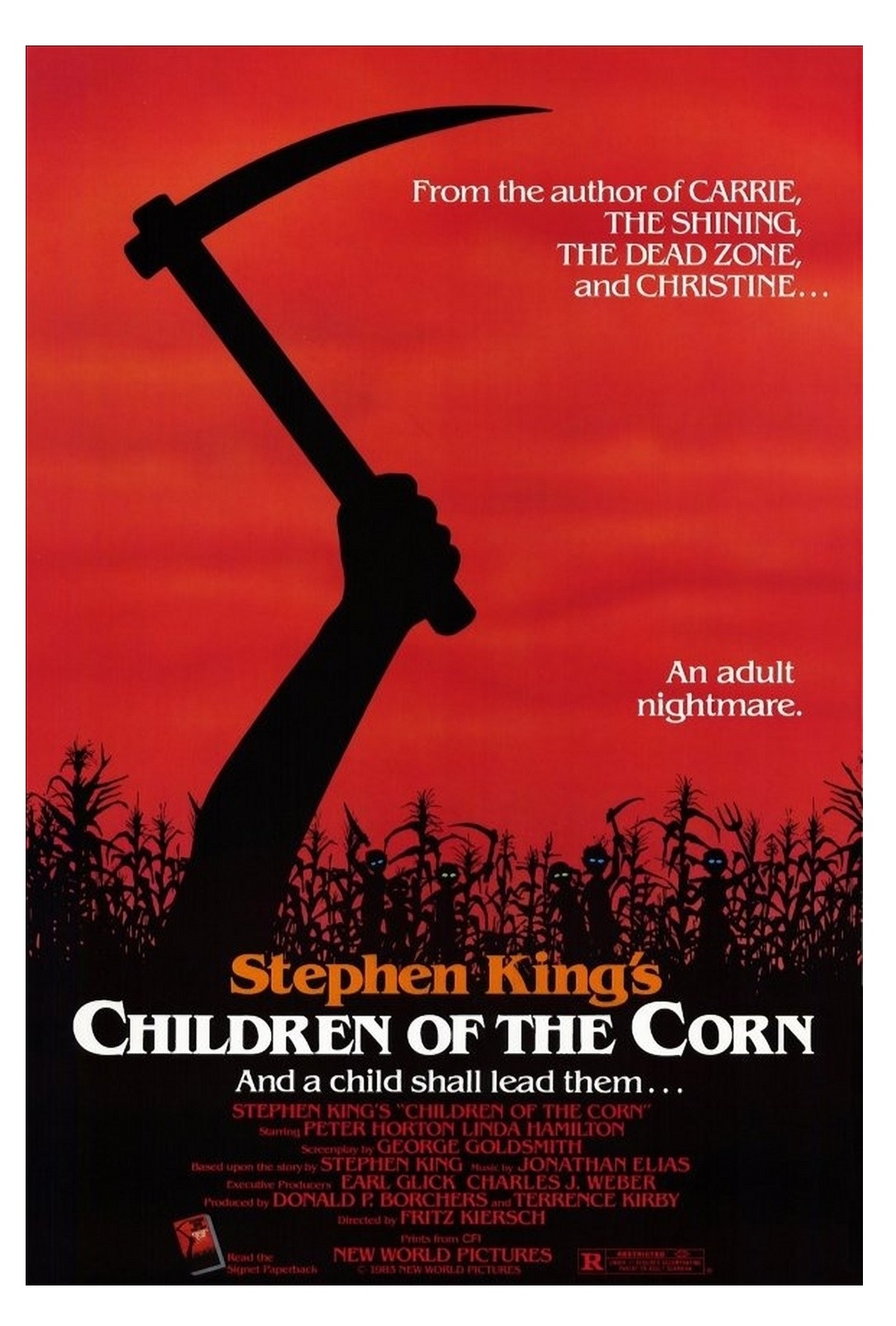
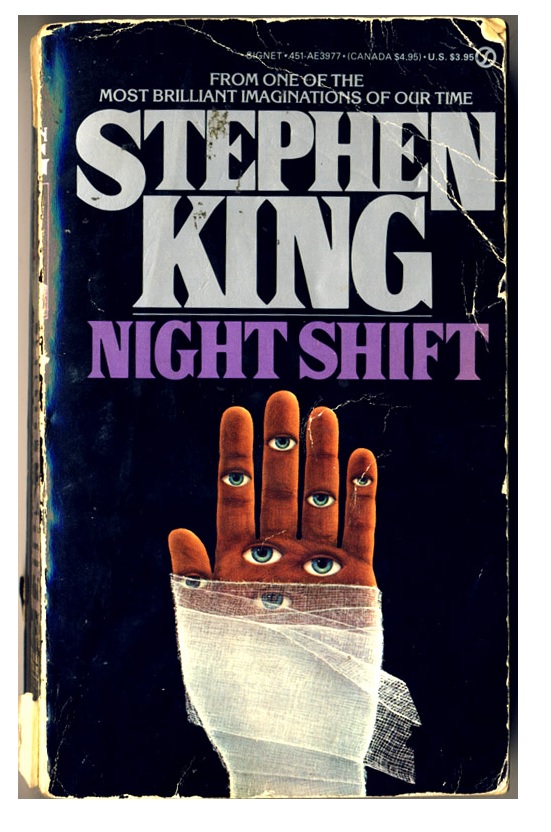 Retro-review: Find this film on Netflix here!
Retro-review: Find this film on Netflix here!CHILDREN OF THE CORN (1984)
Directed by Fritz KierschWritten by George Goldsmith (based on the short story by Stephen King)
Starring Peter Horton, Linda Hamilton, R.G. Armstrong, John Franklin, Courtney Gains, Robby Kiger, Anne Marie McEvoy
Retro-reviewed by Reviewed by: BottleImp
God (or perhaps He Who Walks Behind The Rows) only knows how this movie spawned a franchise. For me, CHILDREN OF THE CORN is a prime example of why trying to expand a fifteen page short story into a feature-length film tends to be a bad idea.
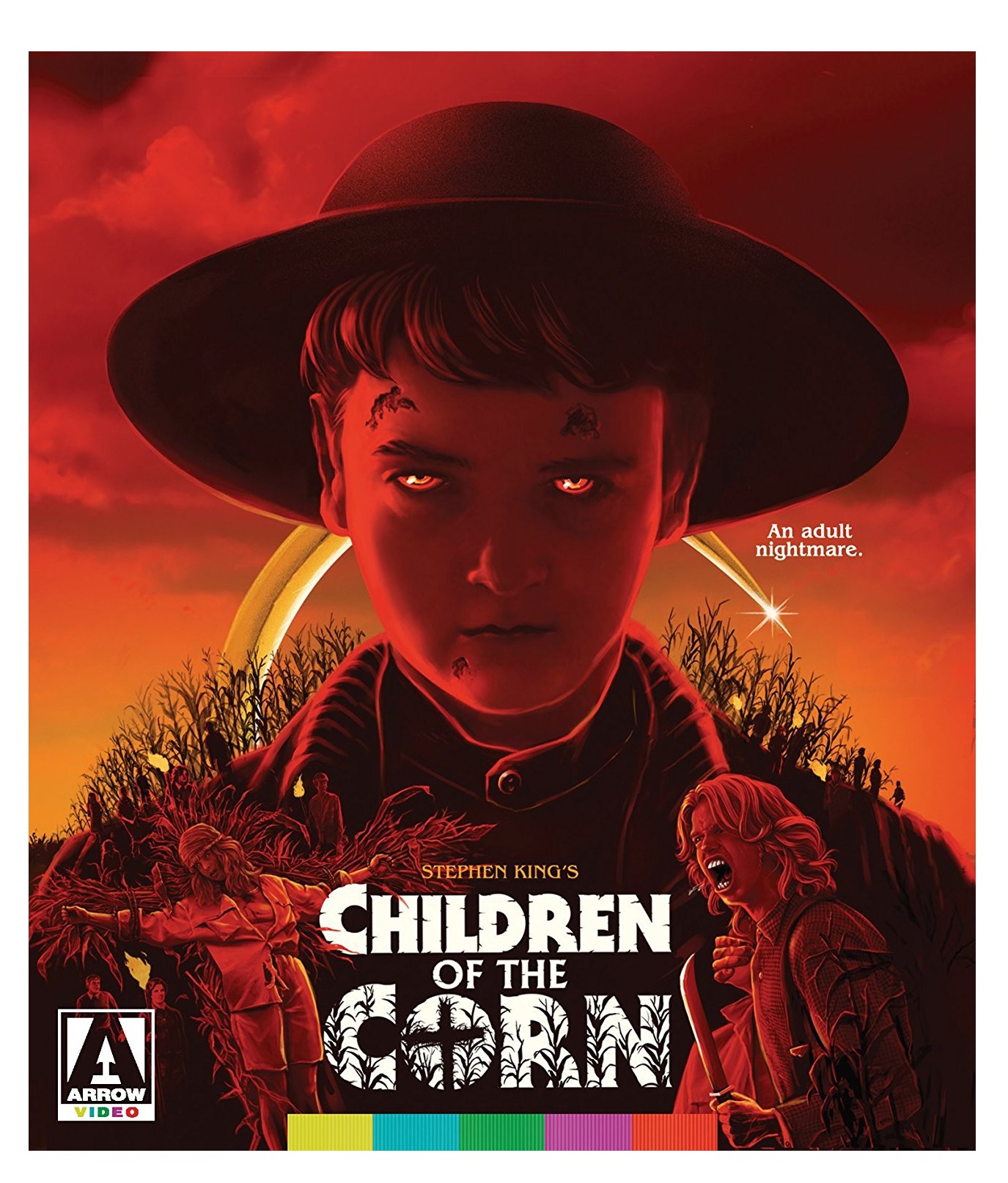 The movie follows a happy young couple, Burt (Peter Horton) and Vicky (Linda Hamilton), as they drive through the Midwest. Their road trip is interrupted when their car strikes a boy emerging from the corn field, but Burt dodges a manslaughter charge when he discovers that the boy’s throat had been cut before his dying body was pushed out into the road. In search of the authorities, Burt and Vicky drive to Gatlin, a seeming ghost town with dried cornstalks in place of tumbleweeds. They soon discover that Gatlin is populated by knife-wielding children who murder adults in accordance with the sermons of the “young” preacher Isaac (John Franklin), acting in service of a mysterious god called “He Who Walks Behind The Rows.” With the help of Job (Robby Kiger) and Sarah (Anne Marie McEvoy), two children who have not fallen under Isaac’s sway, Burt and Vicky try to escape the murderous children of Gatlin.
The movie follows a happy young couple, Burt (Peter Horton) and Vicky (Linda Hamilton), as they drive through the Midwest. Their road trip is interrupted when their car strikes a boy emerging from the corn field, but Burt dodges a manslaughter charge when he discovers that the boy’s throat had been cut before his dying body was pushed out into the road. In search of the authorities, Burt and Vicky drive to Gatlin, a seeming ghost town with dried cornstalks in place of tumbleweeds. They soon discover that Gatlin is populated by knife-wielding children who murder adults in accordance with the sermons of the “young” preacher Isaac (John Franklin), acting in service of a mysterious god called “He Who Walks Behind The Rows.” With the help of Job (Robby Kiger) and Sarah (Anne Marie McEvoy), two children who have not fallen under Isaac’s sway, Burt and Vicky try to escape the murderous children of Gatlin.The story definitely has the potential for horror—after all, killer kids is one of the genre’s creepiest subcategories—but every opportunity is squandered due to bad acting, slow pacing and bizarre plot points. For one thing, the murderous children never come across with any sense of menace; rather than featuring the Children of the Corn as a killer mob, the film instead chooses to concentrate on the leader of the mob, Malachai (Courtney Gains—who will always be “Hans” from THE ‘BURBS to me) and use him as the means to show the evil of the children. The problem is that Malachai’s dialogue is terrible, filled with quasi-religious clichés and pretentious “menacing” threats, and frankly, Gains delivers his lines with all the skill you’d expect from a junior high school production of “Macbeth.” The movie also suffers from a second act that drags along at a snail’s pace as Burt and Vicky wander around Gatlin. “Things just aren’t moving fast enough,” Burt tells Vicky at one point; I am half-convinced that the cameraman just accidentally caught Horton complaining to Hamilton between takes.
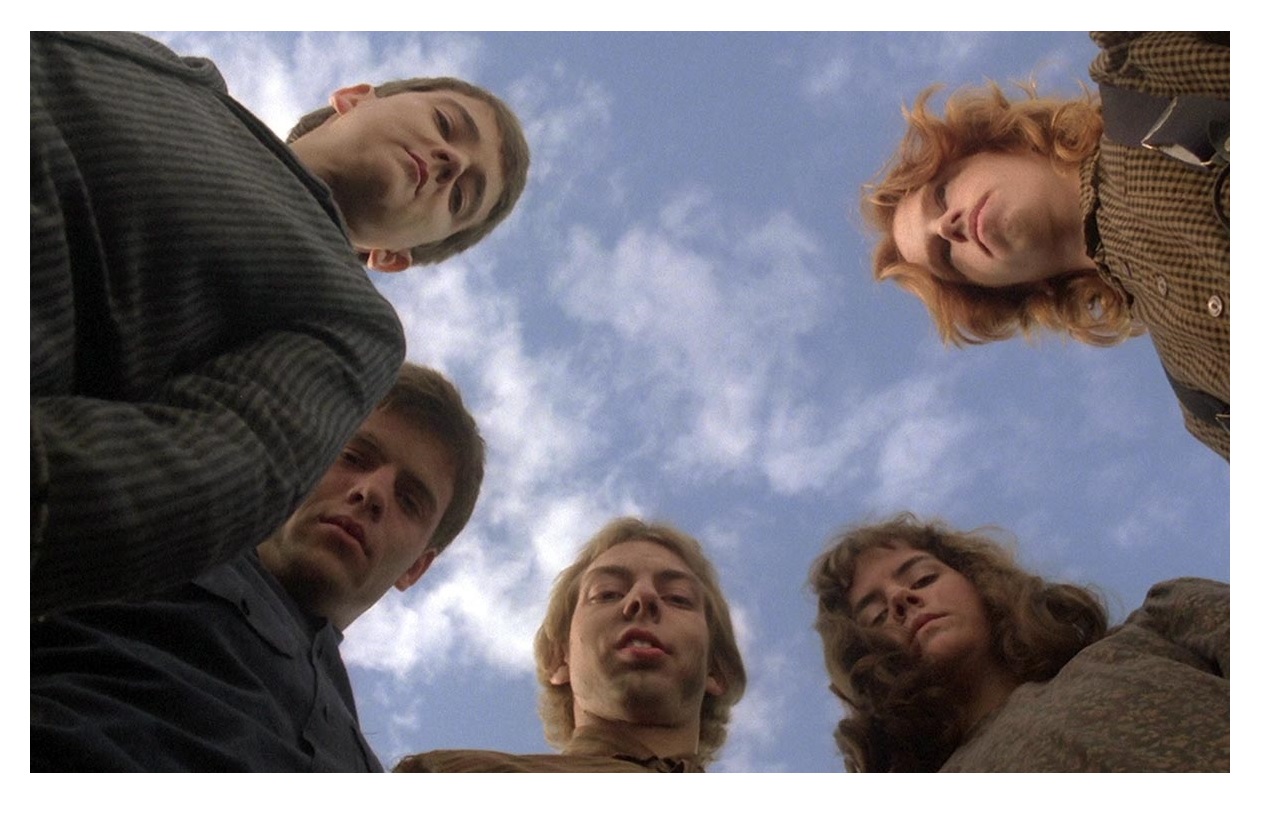 Any palpable sense of menace generated by the flock of children (and it must be said that a lot of these “children” look waaaaaay too old for their roles) is further diminished by the odd choice made to have a rift in management style open between Malachai and Isaac, leading to Malachai usurping the leadership role from the preacher. If your group of killer kids can’t even be counted on to work together, then how hard can it be to get away from them? Also, the whole thing about the visibly aged “kids” is exemplified in Isaac, played by an actor who was 25 years old at time of filming. Franklin may have been child-sized, but it’s impossible to ignore the telltale jowls and fine wrinkles that clearly mark his age.
Any palpable sense of menace generated by the flock of children (and it must be said that a lot of these “children” look waaaaaay too old for their roles) is further diminished by the odd choice made to have a rift in management style open between Malachai and Isaac, leading to Malachai usurping the leadership role from the preacher. If your group of killer kids can’t even be counted on to work together, then how hard can it be to get away from them? Also, the whole thing about the visibly aged “kids” is exemplified in Isaac, played by an actor who was 25 years old at time of filming. Franklin may have been child-sized, but it’s impossible to ignore the telltale jowls and fine wrinkles that clearly mark his age.CHILDREN OF THE CORN is a movie that would be great for a “Mystery Science Theater 300”-style riffing session, from its awkward opening (overlaid with a voice-over narration supplied by Job—clearly added after test screenings, since Job’s narration only pops up once more early on in the film to helpfully describe details that the filmmakers obviously felt would confuse the audience) to the mind-blowingly awful special effects of the film’s climax. Add this movie to the list of Stephen King short story adaptations that just don’t work as full-length films. CHILDREN OF THE CORN joins GRAVEYARD SHIFT and 1408 in the list of movies that would be much scarier if presented in, say, an hour-long television anthology format (such as King’s own “Nightmares and Dreamscapes” from a few years ago). But until that happens you might as well enjoy the unintentional humor of this flick, and go read the original story (from King’s “Night Shift” collection) when you want a real scare.

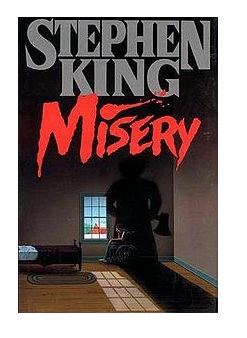 Retro-review: Find this film on Netflix here!
Retro-review: Find this film on Netflix here!MISERY (1990)
Directed by Rob ReinerWritten by William Goldman (based upon the novel by Stephen King)
Starring James Caan, Kathy Bates, Richard Farnsworth
Retro-reviewed by BottleImp
Stephen King’s MISERY is a taut psychological thriller and one of the author’s best books. Stripped down of distracting supernatural elements and convoluted plotlines that have sometimes dragged down King’s prose, the story of a writer tortured by an obsessive fan is a real page-turner filled with some of the purest horror that King has ever evoked. MISERY, the film, captures the gist of the plot in a satisfying way, yet falls short of delivering the punch of terror that the book brings.
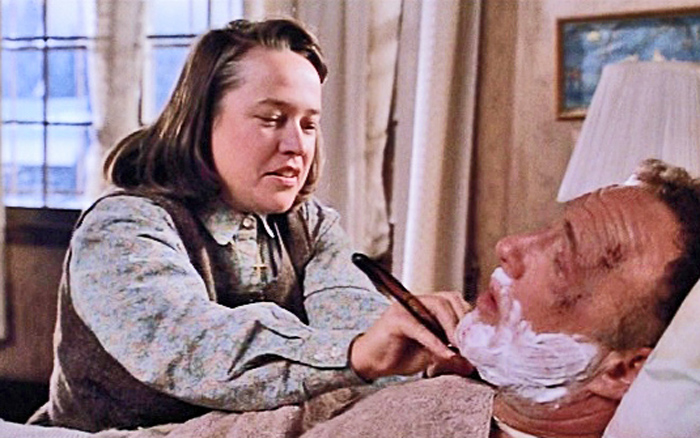 Famous writer of romance novels Paul Sheldon (James Caan) is rescued from a snowy car crash by Annie Wilkes (Kathy Bates), a reclusive farmer who just also happens to be a self-proclaimed “Number One Fan” of Paul and his heroine Misery Chastain. A former nurse, Annie takes care of helping Paul heal from his injuries… until she finishes the latest Misery novel, in which the beloved character has been killed off by her author. Annie forces Paul to write Misery back to life, and what follows is a tense cat-and-mouse thriller as Paul tries to comply with his Number One Fan’s demands and find a way of escaping the increasingly homicidal clutches of his “rescuer.”
Famous writer of romance novels Paul Sheldon (James Caan) is rescued from a snowy car crash by Annie Wilkes (Kathy Bates), a reclusive farmer who just also happens to be a self-proclaimed “Number One Fan” of Paul and his heroine Misery Chastain. A former nurse, Annie takes care of helping Paul heal from his injuries… until she finishes the latest Misery novel, in which the beloved character has been killed off by her author. Annie forces Paul to write Misery back to life, and what follows is a tense cat-and-mouse thriller as Paul tries to comply with his Number One Fan’s demands and find a way of escaping the increasingly homicidal clutches of his “rescuer.”MISERY has a lot of good things going for it—the pacing is tight and the limited locale of Annie’s house (and most of all Paul’s bedroom) helps the viewer empathize with Paul’s captivity—but what really sells the story is Kathy Bates’ brilliant performance as Annie. Bates shifts effortlessly between the various mood swings that plague Paul’s captor, from her initial bubbly jubilance at meeting her favorite author to her rage and horror upon reading Misery’s death, and, most chilling, her cold flat deadness as she contemplates killing both Paul and herself.
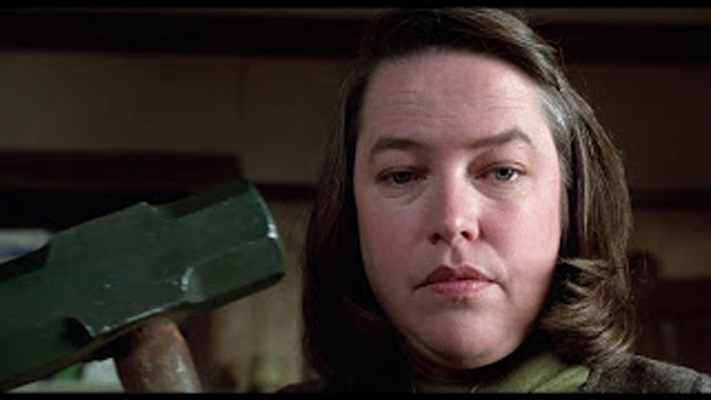 Then there’s the famous “hobbling” scene—definitely the movie’s most scream-inducing moment, and a triumph of special effects.
Then there’s the famous “hobbling” scene—definitely the movie’s most scream-inducing moment, and a triumph of special effects.Ultimately MISERY is a very good movie anchored by its lead actress (who won an Academy Award for her performance), but without the ability to delve into Paul’s mind as King’s book does, the film doesn’t quite give the viewer the emotional impact one gets from reading the novel. My recommendation is if you like the movie, you’ll most likely love the book. If you love the book, you may be slightly disappointed by the film.
 Retro-review: Find this film on Netflix here!
Retro-review: Find this film on Netflix here!SLEEPWALKERS (1992)
Directed by Mick GarrisWritten by Stephen King
Starring Brian Krause, Mädchen Amick, Alice Krige, Jim Haynie, Cindy Pickett, Ron Perlman, Lyman Ward, Dan Martin, Glenn Shadix, Monty Bane, John Landis, Joe Dante, Stephen King, Clive Barker, Tobe Hooper, Mark Hamill
Retro-reviewed by Ambush Bug
One of the weirder King outings, this one boasted to be the first ever King story written directly for the screen and though it does carry with is a lot of King-isms, I can’t qualify this one as one of King’s strongest efforts.
 The story is wrapped around the ancient obscure monster tale of the Sleepwalker, a changeling with mystical abilities and a vulnerability to cats. Now, after this film and CAT’S EYE, I have a hard time figuring out if King loves cats or hates them as both of the films have their fair share of cat torture, but also cast the furry felines as heroes as well. In SLEEPWALKERS, the creatures in question are made weak from the scratch of a cat and find themselves trapped in their house as kitties litter their lawn outside just waiting to pounce. Being a cat lover myself, it’s hard to see the animal torture at the hands of the titular monsters, but it is good to see them come out on top in the end.
The story is wrapped around the ancient obscure monster tale of the Sleepwalker, a changeling with mystical abilities and a vulnerability to cats. Now, after this film and CAT’S EYE, I have a hard time figuring out if King loves cats or hates them as both of the films have their fair share of cat torture, but also cast the furry felines as heroes as well. In SLEEPWALKERS, the creatures in question are made weak from the scratch of a cat and find themselves trapped in their house as kitties litter their lawn outside just waiting to pounce. Being a cat lover myself, it’s hard to see the animal torture at the hands of the titular monsters, but it is good to see them come out on top in the end.The story itself centers on a mother, Mary Brady (Alice Krige) and son Charles (Brain Krause) who move into a small town after leaving their former residence suddenly and with a withered husk of a young woman rotting in the closet. The school is all a flutter as the dreamboat Charles sets his sights on virginal Tanya (Mädchen Amick from TWIN PEAKS). Basically, in order for the Brady’s to survive, they have to suck the soul from a virgin from time to time. Oh and the mom and son team also like to turn into goopy fleshy cat monsters and screw a lot. The incestual nature of the mother and son is not glossed over at all as their first scene shows them interacting as mom and son at first, then they start to make out, a pretty ballsy move in my opinion and one that may have ooked out quite a few moviegoers thinking they were going to see some safe King horror like CUJO, CREEPSHOW, or CAT’S EYE. That detail alone, makes SLEEPWALKERS one of the more creepy King tales.
 Unfortunately, Mick Garris (who directed quite a few King stories), has a pretty no-frills and uninteresting directing style as the story lazily lolls through the motions of a nonsensical tale with scenes put in merely as showcases for the then fresh and new CGI which looks pretty awful in retrospect. For no reason as all, Charles challenges a police officer who of course brings along a cat with him in his police car (WTF?) to a drag race along the back roads of the town. The scene feels like a centerpiece for the film because so much CGI is used from Charles morphing into different cat-like forms to him making the car itself invisible. For some reason, Charles spends a lot of time morphing his car from one form to another throughout the film as well.
Unfortunately, Mick Garris (who directed quite a few King stories), has a pretty no-frills and uninteresting directing style as the story lazily lolls through the motions of a nonsensical tale with scenes put in merely as showcases for the then fresh and new CGI which looks pretty awful in retrospect. For no reason as all, Charles challenges a police officer who of course brings along a cat with him in his police car (WTF?) to a drag race along the back roads of the town. The scene feels like a centerpiece for the film because so much CGI is used from Charles morphing into different cat-like forms to him making the car itself invisible. For some reason, Charles spends a lot of time morphing his car from one form to another throughout the film as well.The story ends up being pretty simple. The Bradys need a virgin soul to survive. Tanya is a virgin. The Bradys take time out from grinding scruglies to try to suck it out of her. Everything else is either a tribute to other King stories as everything from CHRISTINE to CAT’S EYE is referenced or padding to show off CGI. Characters move through shifts and changes nonsensically, particularly Charles who at first seems to really care about Tanya, then turns into a horn dog beastie intent on raping her in a graveyard with no real in between cause or motive for such action.
 I will say that the incest angle played in SLEEPWALKERS makes for a truly queasy feel to the entire film. There’s even a scene of the two in bed in full Sleepwalker form that looks more like Newt Gingrich rolling around in bed with himself than anything else. A scene you can’t unsee once witnessed.
I will say that the incest angle played in SLEEPWALKERS makes for a truly queasy feel to the entire film. There’s even a scene of the two in bed in full Sleepwalker form that looks more like Newt Gingrich rolling around in bed with himself than anything else. A scene you can’t unsee once witnessed.For what its worth, SLEEPWALKERS has a few fun cameos from King himself, Clive Barker, Joe Dante, Tobe Hooper, John Landis, and Mark Hamill, but these are mere cameos and their inclusion is less clever and feels more like an afterthought. On the plus side, there’s some creepy incest from creepy actress Alice Krige, Madchen Amick is cute as a button, and SLEEPWALKERS does serve as a showcase of how much CGI has developed in the last 20 years. Aside from that, SLEEPWALKERS is for the King completist, but even those will attest that it’s not the strongest of King’s works.
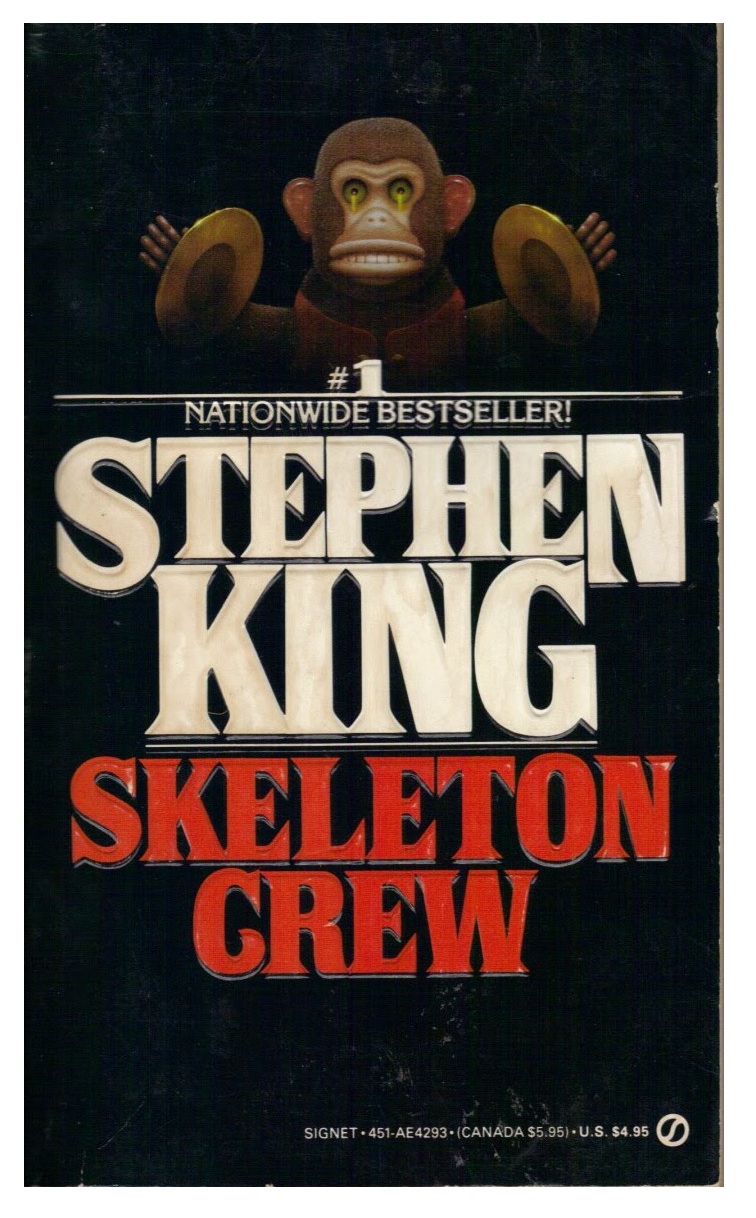
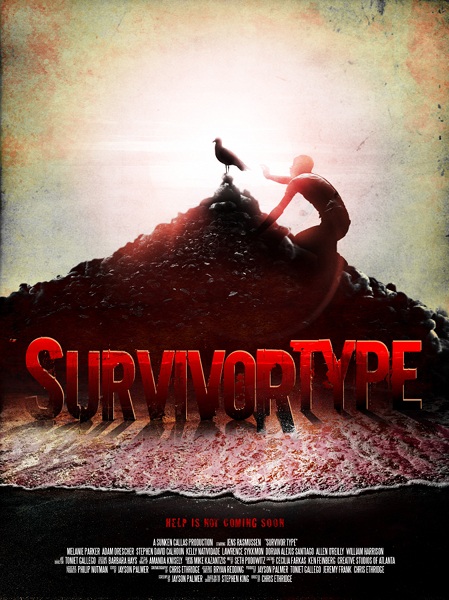
SURVIVOR TYPE (2011)
Directed by Chris EthridgeWritten by Jayson Palmer from a short story by Stephen King
Starring Jens Rasmussen, Melanie Parker, Allen O’Reilly, Stephen David Calhoun
Find out more about this short here!
Reviewed by Ambush Bug
Probably one of my favorite short stories by Stephen King, SURVIVOR TYPE is a story that is an extremely difficult film to get right. The short story is a series of journal entries from a man stranded on a desert island. It’s a descent into madness tale, sort of the evil doppelganger of Tom Hanks’ CAST AWAY that I always found to be both terrifying and nauseating in the effectiveness of King’s description of the chipping away of the man’s mind as well as the description of his body slowly falling apart from exposure and a particularly gruesome accident suffered on the island.
Directed by David Calhoun, SURVIVOR TYPE the short film does King’s short story proud. It hits all of the right beats of the story and does a great job of showing one man’s slow fall into utter insanity. Though some of the acting is a bit amateur and some of the effects are not the best, the story is still solidly put together and the gruesome ending still packs a whallop. I wish the director would have stayed on the island more, relying on more narration as if the man was reading from his journal, but the story that unfolded will make you wince and scream more than once at the grueling events that happen to this desperate shipwrecked man. SURVIVOR TYPE is a worthy translation of King’s short and no fan of the King’s work should miss it.
Survivor Type Trailer from Sunken Callas Productions on Vimeo.
Here’s a reading of the whole thrilling story. I dare you not to wince while listening to it!

JOYLAND Fiction Novel (2013)
Written by Stephen KingPublished by Hard Case Crime
Book Reviewed by BottleImp
Let me make one thing absolutely crystal clear: JOYLAND is not a horror novel. In fact, it barely even qualifies as a crime thriller. Don’t let the tagline “Who Dares Enter the FUNHOUSE OF FEAR?” fool you, nor should you get suckered in by the awesomely retro-pulp cover (painted by Glen Orbik) or even the name of the publishing house itself. Stephen King’s new novel is not one of horror—though there are elements in the story that fit the traditional trappings of a horror story—and it isn’t one of crime—though there is a murder mystery threaded through the plot. At its heart JOYLAND is a story about life, death, love and that age-old trial of growing up.
Narrated by its main character, JOYLAND is the story of twenty-one year old Devin Jones, a New Hampshire college student working his summer at the Joyland Amusement Park in North Carolina. Spending the summer apart from his first serious girlfriend, Devin experiences the angst of watching his relationship crumble away while at the same time discovering a new happiness within himself while working at Joyland. He becomes a part of that secret organization known the country-over as carnies, learning the language of the carnival barker… and learning the dark secrets that the carnivals can hide.
Four years before Devin came down to work at the park, a girl named Linda Gray was murdered in the Joyland Horror House ride, her body found by the carnival workers the following day, her killer never found. Legend has it that her ghost still haunts the Horror House Ride where he body was found. This little hint of the supernatural ebbs and grows through the story, but the ghost of Linda Gray is always there in the corner of Dev’s mind. The supernatural aspect is heightened when Dev meets Mike Ross, a young boy with crippling muscular dystrophy who seems to have some psychic ability. But it isn’t the supernatural stuff that grabs the reader’s attention as much as it is the emotional impact of meeting a twelve-year-old boy who knows he’s going to die soon. As much as Devin helps Mike by being his friend, Mike and his mother Annie help Devin to get past his adolescent heartache and grow into adulthood, with all the beauty and pain that it encompasses.
As I said above, don’t expect to find JOYLAND to be a straight-up horror story. There are times when King thickens the atmosphere with a darker mood; the description of the Linda Gray murder has a certain eeriness, and a scene of Devin’s nightmare that comes towards the end of the book could easily have been transposed from one of King’s gorier books. The climax of the story, set during a hurricane-whipped rainstorm, would feel equally at place in a clear-cut horror or thriller genre novel. But JOYLAND is really a coming-of-age story that shares more in common with King’s HEARTS IN ATLANTIS or THE BODY (which most moviegoers will know better by its filmed version STAND BY ME) than it does IT or THE SHINING. With the supernatural elements stripped down to a bare minimum, JOYLAND allows King’s gift for writing believable, human characters to shine through. It’s this quality in his writing that makes King’s work so memorable and engrossing; with a Stephen King book the reader really cares for the characters and becomes invested in their fates. This is what elevates King’s books above the stigma of being “merely” horror stories, and it’s what makes JOYLAND such an engaging book.
King has a crafted a story that is sweet and sentimental without becoming cloying or manipulative. Devin’s lovesick summer neither feels phony nor melodramatic; the ups and downs of his moods are perfectly recognizable to anyone who’s ever been at that age or in an unavoidably doomed relationship. And King’s expert intertwining of the book’s various elements—Devin’s love life, the mingled struggle and joy of his work at Joyland, the fascinating secret world and language of the carny, Michael Ross and his heartbroken mother, and, of course, the underlying mystery of the murder of Linda Gray—draws the reader firmly into this deeply felt world of love and loss.
So if you’re hoping to read a book about a carnival killer—possibly an insane clown or renegade from the freak show—you’re going to be severely disappointed. But if your only criterion for a good book is that it be a good book, then King’s JOYLAND is definitely worth reading.
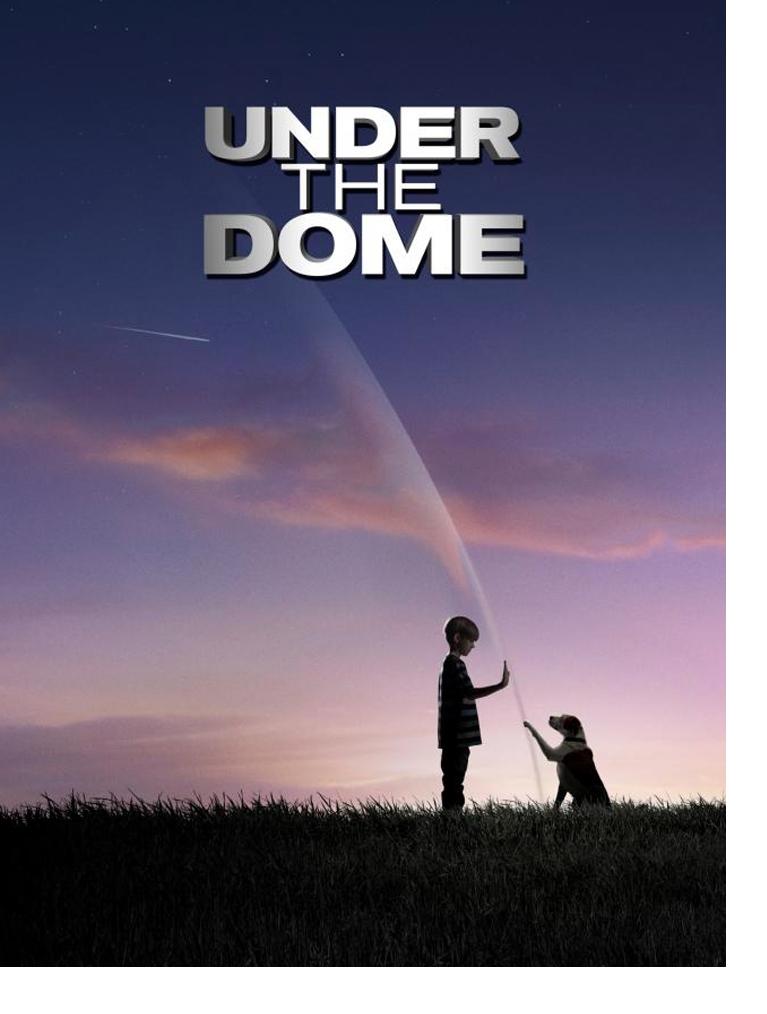
 Airing Monday nights this summer on CBS!
Airing Monday nights this summer on CBS!UNDER THE DOME Episodes 1-2 (2013)
Directed by Niels Arden Oplev (Pilot), Jack Bender (Episode 2)Written by Brian K. Vaughan (based upon the novel by Stephen King)
Starring Dean Norris, Jeff Fahey, Alexander Koch, Nicholas Strong, Jolene Purdy, Aisha Hinds, Colin Ford, Mike Vogel, Rachelle Lefevre, Natalie Martinez, Britt Robertson, Mackenzie Lintz
Reviewed by Ambush Bug
Though I rarely have time to watch many television shows religiously these days, when I know a series is being overseen by comic book writer/TV writer Brian K. Vaughan, I stand up and take notice. The writer of some of my favorite comics including Y: THE LAST MAN, PRIDE, and his most recent SAGA, proved to me that he is one of those writers I will follow religiously. Team him up with Stephen King and reunite him with the producers of LOST (a series Vaughan also wrote for), and you’re damn spanky I’m in for the ride.
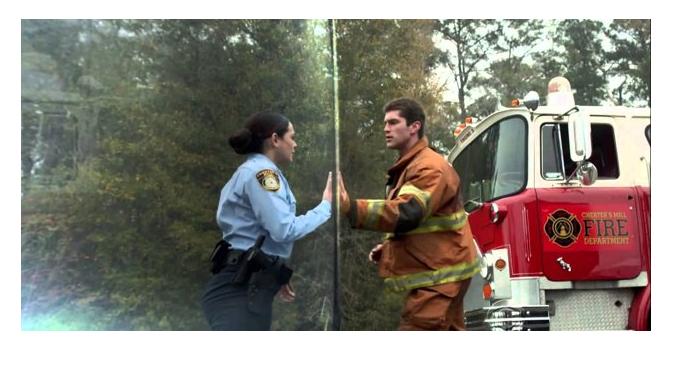 And the first episode of UNDER THE DOME was pretty fun. There’s a lot of set up, but that’s what a pilot episode is all about. The town of Chester’s Mill seems to be a normal small town where people know each other’s business. It’s the kind of town that the old feel settled and happy and the young try to leave as soon as they can. So in many ways, when an invisible dome plops down out of the blue, cutting off Chester’s Mill from the rest of the world, it serves as a pretty rich metaphor in regards to small town America, the values that attract some to it, and the detractors the young feel about breaking away from it. Setting a group of people in this situation where they are forced to stay in a town is as compelling as…say…trapping them on an island.
And the first episode of UNDER THE DOME was pretty fun. There’s a lot of set up, but that’s what a pilot episode is all about. The town of Chester’s Mill seems to be a normal small town where people know each other’s business. It’s the kind of town that the old feel settled and happy and the young try to leave as soon as they can. So in many ways, when an invisible dome plops down out of the blue, cutting off Chester’s Mill from the rest of the world, it serves as a pretty rich metaphor in regards to small town America, the values that attract some to it, and the detractors the young feel about breaking away from it. Setting a group of people in this situation where they are forced to stay in a town is as compelling as…say…trapping them on an island.And that’s basically my only complaint about this series. Maybe it’s because the ads highlight that this is from the folks who brought you LOST. Or maybe it’s about a group of people trapped in one location cut off from the rest of the world. Or maybe it’s because I can go through the entire cast and basically match them up with a counterpart from LOST. It’s hard not to think about that series while watching this one as you can point out this series Jack and Kate and Hurley and Said and Charlie and Claire one by one as you get to know them. In the end, this definitely brought me out of the story and made me wonder if this was a series worth investing in.
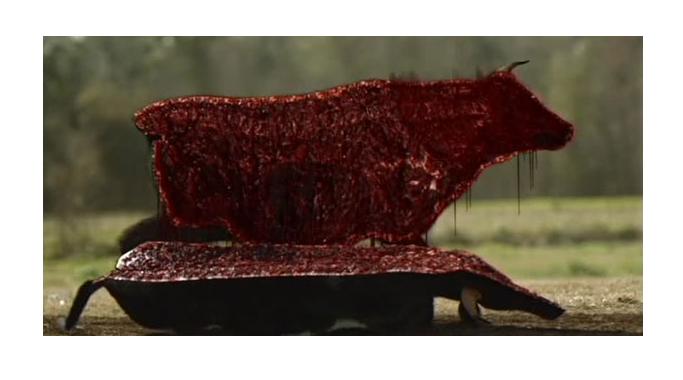 But the pilot episode does a lot to make me want to possibly take residence under this dome. There’s a nicely set up conflict between Angie a spunky waitress (Britt Robertson) and a possessive son of the mayor Junior (Alexander Koch). There’s a bit of conspiracy between the mayor Big Jim (BREAKING BAD’s Dean Norris) and the sheriff who goes by “Duke” (played by the ever-awesome Jeff Fahey) involving some reason they were stockpiling fuel right before the dome dropped. And the obvious Jack/Sawyer and Kate riffs Mike Foley (BATES MOTEL) and Rachelle LaFevre (TWILIGHT) seem likable enough to make for nice romantic leads.
But the pilot episode does a lot to make me want to possibly take residence under this dome. There’s a nicely set up conflict between Angie a spunky waitress (Britt Robertson) and a possessive son of the mayor Junior (Alexander Koch). There’s a bit of conspiracy between the mayor Big Jim (BREAKING BAD’s Dean Norris) and the sheriff who goes by “Duke” (played by the ever-awesome Jeff Fahey) involving some reason they were stockpiling fuel right before the dome dropped. And the obvious Jack/Sawyer and Kate riffs Mike Foley (BATES MOTEL) and Rachelle LaFevre (TWILIGHT) seem likable enough to make for nice romantic leads.The first episode does everything right by introducing the overall conflict (the dome) and peppering in smaller conflicts as well. This is the type of storytelling that was perfected with LOST as the overall mystery is the thread that inches along for the season or two or six, while there seems to be some kind of plot movement by incorporating smaller arcs along the way. It’s TV serial storytelling 101 and hits all the beats nicely.
Plus the pilot has a lot of little beats that make for some fun, most notably the cow which is bisected when the dome appears or the underground bunker Junior likes to hang out in. These little touches seem trivial, but they’ll be the ones that keep folks coming back for more. I know it worked for me.
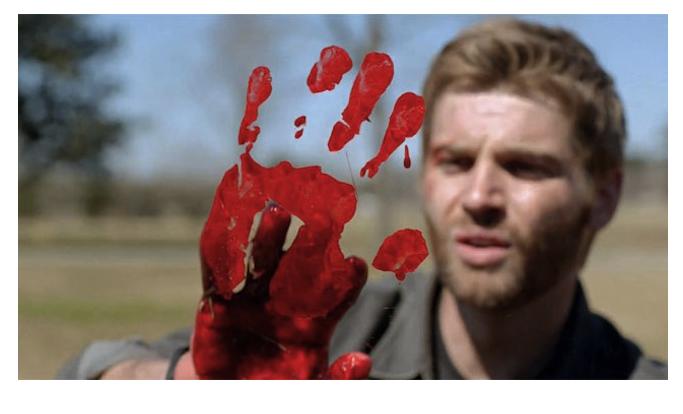 Episode two amps up the tension within as a cop gets paranoid, a stalker ups the ante, and the town struggles with a fire. Though a surprising death in the opening moments both took me back and disappointed me since I love this actor, the second installment proved to be just as engaging as the first. What does distinguish this series from LOST is that the basics of modern civilization are still around, only in short quantity. There are hints here that things will be going THUNDERDOME soon enough as people are starting to stockpile and tensions rise as the expansive dome proves to be too tight for many. Nicely directed and more focused than the first, the second episode left me with even more of a feeling that I want to know how this all pans out.
Episode two amps up the tension within as a cop gets paranoid, a stalker ups the ante, and the town struggles with a fire. Though a surprising death in the opening moments both took me back and disappointed me since I love this actor, the second installment proved to be just as engaging as the first. What does distinguish this series from LOST is that the basics of modern civilization are still around, only in short quantity. There are hints here that things will be going THUNDERDOME soon enough as people are starting to stockpile and tensions rise as the expansive dome proves to be too tight for many. Nicely directed and more focused than the first, the second episode left me with even more of a feeling that I want to know how this all pans out.That’s it, I’m hooked. UNDER THE DOME has enough going for it for me to ignore the striking similarities with LOST. Though many have tried to reproduce the lightning in a bottle LOST accomplished, most feel like rip-offs. For some reason UNDER THE DOME doesn’t feel that way. Though not as scary as most of King’s stuff, I haven’t read the book, so I don’t know how it compares. I have heard that many of the main characters are different from the novel. Still, the overall mystery is intriguing and at this point, the dome could be anything from aliens to top secret government tech. Here’s hoping that the solution resolves itself better than LOST did (and isn’t as prolonged as that series ended up being), but as far as openers are concerned, it’s promising enough to have me interested.
And finally…let’s leave this little tribute to the King with a couple different variations of what I consider to be the best King adaptation. Yes, I know Kubrick changed it significantly, but still THE SHINING is a classic as evidenced by these fantastically fun riffs on the film. Enjoy!
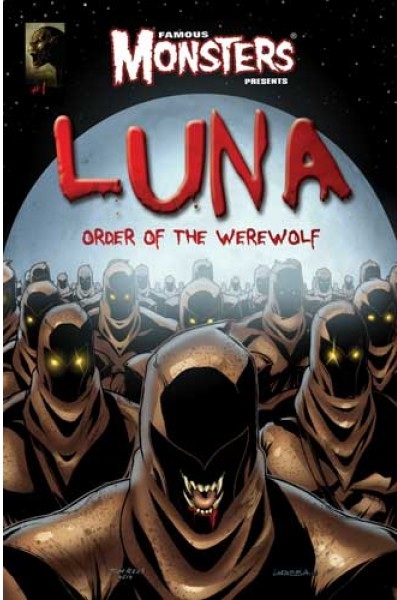
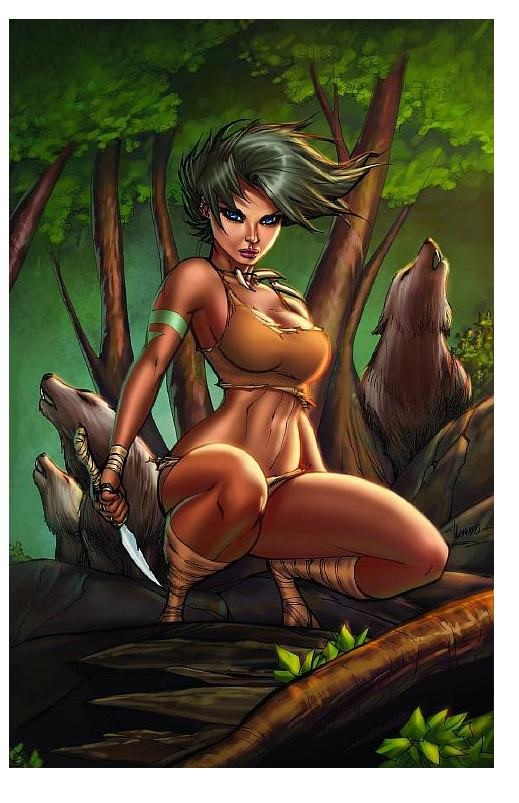 Ambush Bug is Mark L. Miller, original @$$Hole/wordslinger/writer of wrongs/reviewer/interviewer/editor of AICN COMICS for over 12 years & AICN HORROR for 3. He has written comics such as VINCENT PRICE PRESENTS THE TINGLERS & WITCHFINDER GENERAL, THE DEATHSPORT GAMES, & NANNY & HANK (soon to be made into a feature film from Uptown 6 Films). He has co-written FAMOUS MONSTERS OF FILMLAND’s LUNA: ORDER OF THE WEREWOLF (to be released in 2013 as a 100-pg original graphic novel). Mark wrote the critically acclaimed GRIMM FAIRY TALES PRESENTS THE JUNGLE BOOK from Zenescope Entertainment & GRIMM FAIRY TALES #76-81. Look for GRIMM FAIRY TALES PRESENTS THE JUNGLE BOOK: LAST OF THE SPECIES available in February-July 2013 and the new UNLEASHED crossover miniseries GRIMM FAIRY TALES PRESENTS WEREWOLVES: THE HUNGER #1-3 available in May-July 2013! Follow Ambush Bug on the Twitter @Mark_L_Miller.
Ambush Bug is Mark L. Miller, original @$$Hole/wordslinger/writer of wrongs/reviewer/interviewer/editor of AICN COMICS for over 12 years & AICN HORROR for 3. He has written comics such as VINCENT PRICE PRESENTS THE TINGLERS & WITCHFINDER GENERAL, THE DEATHSPORT GAMES, & NANNY & HANK (soon to be made into a feature film from Uptown 6 Films). He has co-written FAMOUS MONSTERS OF FILMLAND’s LUNA: ORDER OF THE WEREWOLF (to be released in 2013 as a 100-pg original graphic novel). Mark wrote the critically acclaimed GRIMM FAIRY TALES PRESENTS THE JUNGLE BOOK from Zenescope Entertainment & GRIMM FAIRY TALES #76-81. Look for GRIMM FAIRY TALES PRESENTS THE JUNGLE BOOK: LAST OF THE SPECIES available in February-July 2013 and the new UNLEASHED crossover miniseries GRIMM FAIRY TALES PRESENTS WEREWOLVES: THE HUNGER #1-3 available in May-July 2013! Follow Ambush Bug on the Twitter @Mark_L_Miller.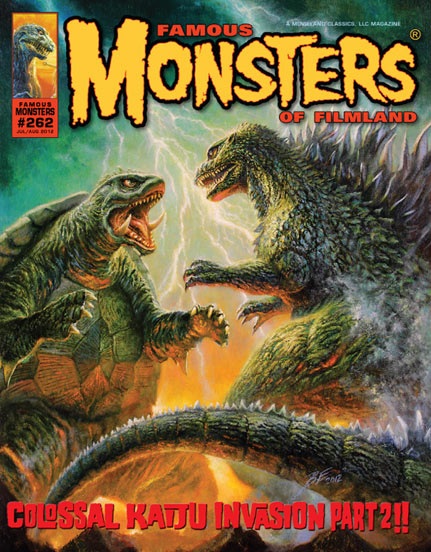
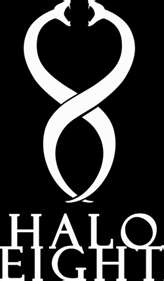
Interested in illustrated films, fringe cinema, and other oddities?
Check out Halo-8 and challenge everything!
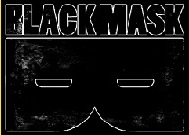
Find more AICN HORROR including an archive of previous columns on AICN HORROR’s Facebook page!
